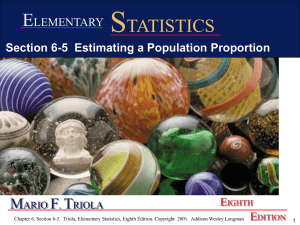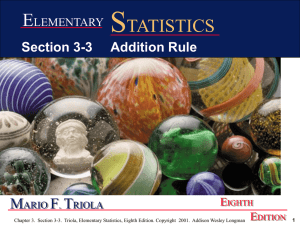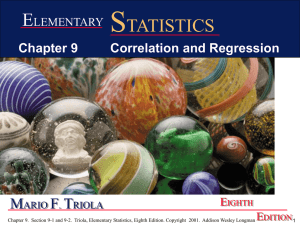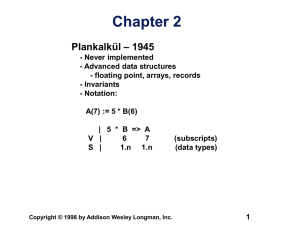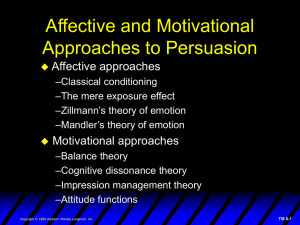Chapter 6 Estimates and Sample Sizes
advertisement
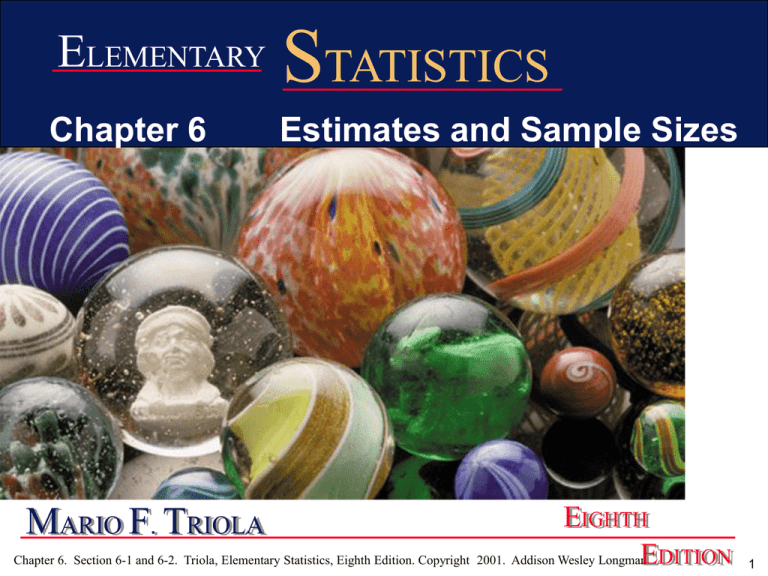
ELEMENTARY STATISTICS Chapter 6 Estimates and Sample Sizes EIGHTH EDITION Chapter 6. Section 6-1 and 6-2. Triola, Elementary Statistics, Eighth Edition. Copyright 2001. Addison Wesley Longman MARIO F. TRIOLA 1 Chapter 6 Estimates and Sample Sizes 6-1 Overview 6-2 Estimating a Population Mean: Large Samples 6-3 Estimating a Population Mean: Small Samples 6-4 Sample Size Required to Estimate µ 6-5 Estimating a Population Proportion 6-6 Estimating a Population Variance Chapter 6. Section 6-1 and 6-2. Triola, Elementary Statistics, Eighth Edition. Copyright 2001. Addison Wesley Longman 2 6-1 Overview This chapter presents: methods for estimating population means, proportions, and variances methods for determining sample sizes Chapter 6. Section 6-1 and 6-2. Triola, Elementary Statistics, Eighth Edition. Copyright 2001. Addison Wesley Longman 3 6-2 Estimating a Population Mean: Large Samples Chapter 6. Section 6-1 and 6-2. Triola, Elementary Statistics, Eighth Edition. Copyright 2001. Addison Wesley Longman 4 Assumptions n > 30 The sample must have more than 30 values. Simple Random Sample All samples of the same size have an equal chance of being selected. Chapter 6. Section 6-1 and 6-2. Triola, Elementary Statistics, Eighth Edition. Copyright 2001. Addison Wesley Longman 5 Assumptions n > 30 The sample must have more than 30 values. Simple Random Sample All samples of the same size have an equal chance of being selected. Data collected carelessly can be absolutely worthless, even if the sample is quite large. Chapter 6. Section 6-1 and 6-2. Triola, Elementary Statistics, Eighth Edition. Copyright 2001. Addison Wesley Longman 6 Estimator Definitions a formula or process for using sample data to estimate a population parameter Estimate a specific value or range of values used to approximate some population parameter Point Estimate a single value (or point) used to approximate a population parameter Chapter 6. Section 6-1 and 6-2. Triola, Elementary Statistics, Eighth Edition. Copyright 2001. Addison Wesley Longman 7 Estimator Definitions a formula or process for using sample data to estimate a population parameter Estimate a specific value or range of values used to approximate some population parameter Point Estimate a single value (or point) used to approximate a population parameter The sample mean x is the best point estimate of the population mean µ. Chapter 6. Section 6-1 and 6-2. Triola, Elementary Statistics, Eighth Edition. Copyright 2001. Addison Wesley Longman 8 Definition Confidence Interval (or Interval Estimate) a range (or an interval) of values used to estimate the true value of the population parameter Chapter 6. Section 6-1 and 6-2. Triola, Elementary Statistics, Eighth Edition. Copyright 2001. Addison Wesley Longman 9 Definition Confidence Interval (or Interval Estimate) a range (or an interval) of values used to estimate the true value of the population parameter Lower # < population parameter < Upper # Chapter 6. Section 6-1 and 6-2. Triola, Elementary Statistics, Eighth Edition. Copyright 2001. Addison Wesley Longman 10 Definition Confidence Interval (or Interval Estimate) a range (or an interval) of values used to estimate the true value of the population parameter Lower # < population parameter < Upper # As an example Lower # < < Upper # Chapter 6. Section 6-1 and 6-2. Triola, Elementary Statistics, Eighth Edition. Copyright 2001. Addison Wesley Longman 11 Definition Degree of Confidence (level of confidence or confidence coefficient) the probability 1 - (often expressed as the equivalent percentage value) that is the relative frequency of times the confidence interval actually does contain the population parameter, assuming that the estimation process is repeated a large number of times usually 90%, 95%, or 99% ( = 10%), ( = 5%), ( = 1%) Chapter 6. Section 6-1 and 6-2. Triola, Elementary Statistics, Eighth Edition. Copyright 2001. Addison Wesley Longman 12 Interpreting a Confidence Interval 98.08 < µ < 98.32 o o Correct: We are 95% confident that the interval from 98.08 to 98.32 actually does contain the true value of . This means that if we were to select many different samples of size 106 and construct the confidence intervals, 95% of them would actually contain the value of the population mean . Wrong: There is a 95% chance that the true value of will fall between 98.08 and 98.32. Chapter 6. Section 6-1 and 6-2. Triola, Elementary Statistics, Eighth Edition. Copyright 2001. Addison Wesley Longman 13 Confidence Intervals from 20 Different Samples Figure 6-1 Chapter 6. Section 6-1 and 6-2. Triola, Elementary Statistics, Eighth Edition. Copyright 2001. Addison Wesley Longman 14 Definition Critical Value the number on the borderline separating sample statistics that are likely to occur from those that are unlikely to occur. The number z/2 is a critical value that is a z score with the property that it separates an area /2 in the right tail of the standard normal distribution. Chapter 6. Section 6-1 and 6-2. Triola, Elementary Statistics, Eighth Edition. Copyright 2001. Addison Wesley Longman 15 The Critical Value 2 2 2 -z Figure 6-2 z 2 z=0 z 2 Found from Table A-2 (corresponds to area of 0.5 - 2 ) Chapter 6. Section 6-1 and 6-2. Triola, Elementary Statistics, Eighth Edition. Copyright 2001. Addison Wesley Longman 16 Finding z2 for 95% Degree of Confidence 95% = 5% 2 = 2.5% = .025 .95 .025 -z2 .025 z2 Chapter 6. Section 6-1 and 6-2. Triola, Elementary Statistics, Eighth Edition. Copyright 2001. Addison Wesley Longman 17 Finding z2 for 95% Degree of Confidence 95% = 5% 2 = 2.5% = .025 .95 .025 .025 z2 -z2 Critical Values Chapter 6. Section 6-1 and 6-2. Triola, Elementary Statistics, Eighth Edition. Copyright 2001. Addison Wesley Longman 18 Finding z2 for 95% Degree of Confidence = 0.05 = 0.025 .4750 .025 Use Table A-2 to find a z score of 1.96 Chapter 6. Section 6-1 and 6-2. Triola, Elementary Statistics, Eighth Edition. Copyright 2001. Addison Wesley Longman 19 Finding z2 for 95% Degree of Confidence = 0.05 = 0.025 .4750 .025 Use Table A-2 to find a z score of 1.96 z2 = 1.96 .025 - 1.96 .025 1.96 Chapter 6. Section 6-1 and 6-2. Triola, Elementary Statistics, Eighth Edition. Copyright 2001. Addison Wesley Longman 20 Definition Margin of Error is the maximum likely difference observed between sample mean x and true population mean µ. denoted by E Chapter 6. Section 6-1 and 6-2. Triola, Elementary Statistics, Eighth Edition. Copyright 2001. Addison Wesley Longman 21 Definition Margin of Error is the maximum likely difference observed between sample mean x and true population mean µ. denoted by E x -E µ x +E Chapter 6. Section 6-1 and 6-2. Triola, Elementary Statistics, Eighth Edition. Copyright 2001. Addison Wesley Longman 22 Definition Margin of Error is the maximum likely difference observed between sample mean x and true population mean µ. denoted by E x -E µ x +E x -E < µ < x +E Chapter 6. Section 6-1 and 6-2. Triola, Elementary Statistics, Eighth Edition. Copyright 2001. Addison Wesley Longman 23 Definition Margin of Error is the maximum likely difference observed between sample mean x and true population mean µ. denoted by E x -E µ x +E x -E < µ < x +E lower limit upper limit Chapter 6. Section 6-1 and 6-2. Triola, Elementary Statistics, Eighth Edition. Copyright 2001. Addison Wesley Longman 24 Definition Margin of Error E = z/2 • x -E Formula 6-1 n µ x +E Chapter 6. Section 6-1 and 6-2. Triola, Elementary Statistics, Eighth Edition. Copyright 2001. Addison Wesley Longman 25 Definition Margin of Error E = z/2 • x -E Formula 6-1 n µ x +E also called the maximum error of the estimate Chapter 6. Section 6-1 and 6-2. Triola, Elementary Statistics, Eighth Edition. Copyright 2001. Addison Wesley Longman 26 Calculating E When Is Unknown If n > 30, we can replace in Formula 61 by the sample standard deviation s. If n 30, the population must have a normal distribution and we must know to use Formula 6-1. Chapter 6. Section 6-1 and 6-2. Triola, Elementary Statistics, Eighth Edition. Copyright 2001. Addison Wesley Longman 27 Confidence Interval (or Interval Estimate) for Population Mean µ (Based on Large Samples: n >30) x -E <µ< x +E Chapter 6. Section 6-1 and 6-2. Triola, Elementary Statistics, Eighth Edition. Copyright 2001. Addison Wesley Longman 28 Confidence Interval (or Interval Estimate) for Population Mean µ (Based on Large Samples: n >30) x -E <µ< x +E µ=x +E Chapter 6. Section 6-1 and 6-2. Triola, Elementary Statistics, Eighth Edition. Copyright 2001. Addison Wesley Longman 29 Confidence Interval (or Interval Estimate) for Population Mean µ (Based on Large Samples: n >30) x -E <µ< x +E µ=x +E (x + E, x - E) Chapter 6. Section 6-1 and 6-2. Triola, Elementary Statistics, Eighth Edition. Copyright 2001. Addison Wesley Longman 30 Procedure for Constructing a Confidence Interval for µ ( Based on a Large Sample: n > 30 ) 1. Find the critical value z2 that corresponds to the desired degree of confidence. Chapter 6. Section 6-1 and 6-2. Triola, Elementary Statistics, Eighth Edition. Copyright 2001. Addison Wesley Longman 31 Procedure for Constructing a Confidence Interval for µ ( Based on a Large Sample: n > 30 ) 1. Find the critical value z2 that corresponds to the desired degree of confidence. 2. Evaluate the margin of error E = z2 • / n . If the population standard deviation is unknown, use the value of the sample standard deviation s provided that n > 30. Chapter 6. Section 6-1 and 6-2. Triola, Elementary Statistics, Eighth Edition. Copyright 2001. Addison Wesley Longman 32 Procedure for Constructing a Confidence Interval for µ ( Based on a Large Sample: n > 30 ) 1. Find the critical value z2 that corresponds to the desired degree of confidence. 2. Evaluate the margin of error E = z2 • / n . If the population standard deviation is unknown, use the value of the sample standard deviation s provided that n > 30. 3. Find the values of x - E and x + E. Substitute those values in the general format of the confidence interval: x - E < µ < x + E Chapter 6. Section 6-1 and 6-2. Triola, Elementary Statistics, Eighth Edition. Copyright 2001. Addison Wesley Longman 33 Procedure for Constructing a Confidence Interval for µ ( Based on a Large Sample: n > 30 ) 1. Find the critical value z2 that corresponds to the desired degree of confidence. 2. Evaluate the margin of error E = z2 • / n . If the population standard deviation is unknown, use the value of the sample standard deviation s provided that n > 30. 3. Find the values of x - E and x + E. Substitute those values in the general format of the confidence interval: x - E < µ < x + E 4. Round using the confidence intervals roundoff rules. Chapter 6. Section 6-1 and 6-2. Triola, Elementary Statistics, Eighth Edition. Copyright 2001. Addison Wesley Longman 34 Round-Off Rule for Confidence Intervals Used to Estimate µ 1. When using the original set of data, round the confidence interval limits to one more decimal place than used in original set of data. Chapter 6. Section 6-1 and 6-2. Triola, Elementary Statistics, Eighth Edition. Copyright 2001. Addison Wesley Longman 35 Round-Off Rule for Confidence Intervals Used to Estimate µ 1. When using the original set of data, round the confidence interval limits to one more decimal place than used in original set of data. 2. When the original set of data is unknown and only the summary statistics (n, x, s) are used, round the confidence interval limits to the same number of decimal places used for the sample mean. Chapter 6. Section 6-1 and 6-2. Triola, Elementary Statistics, Eighth Edition. Copyright 2001. Addison Wesley Longman 36 Example: A study found the body temperatures of 106 healthy adults. The sample mean was 98.2 degrees and the sample standard deviation was 0.62 degrees. Find the margin of error E and the 95% confidence interval. Chapter 6. Section 6-1 and 6-2. Triola, Elementary Statistics, Eighth Edition. Copyright 2001. Addison Wesley Longman 37 Example: A study found the body temperatures of 106 healthy adults. The sample mean was 98.2 degrees and the sample standard deviation was 0.62 degrees. Find the margin of error E and the 95% confidence interval. n = 106 x = 98.2o s = 0.62o = 0.05 /2 = 0.025 z / 2 = 1.96 Chapter 6. Section 6-1 and 6-2. Triola, Elementary Statistics, Eighth Edition. Copyright 2001. Addison Wesley Longman 38 Example: A study found the body temperatures of 106 healthy adults. The sample mean was 98.2 degrees and the sample standard deviation was 0.62 degrees. Find the margin of error E and the 95% confidence interval. n = 106 x = 98.20o s = 0.62o E = z / 2 • n = 1.96 • 0.62 106 = 0.12 = 0.05 /2 = 0.025 z / 2 = 1.96 Chapter 6. Section 6-1 and 6-2. Triola, Elementary Statistics, Eighth Edition. Copyright 2001. Addison Wesley Longman 39 Example: A study found the body temperatures of 106 healthy adults. The sample mean was 98.2 degrees and the sample standard deviation was 0.62 degrees. Find the margin of error E and the 95% confidence interval. n = 106 x = 98.20o s = 0.62o = 0.05 /2 = 0.025 z / 2 = 1.96 E = z / 2 • n = 1.96 • 0.62 106 = 0.12 x -E << x +E Chapter 6. Section 6-1 and 6-2. Triola, Elementary Statistics, Eighth Edition. Copyright 2001. Addison Wesley Longman 40 Example: A study found the body temperatures of 106 healthy adults. The sample mean was 98.2 degrees and the sample standard deviation was 0.62 degrees. Find the margin of error E and the 95% confidence interval. n = 106 x = 98.20o s = 0.62o = 0.05 /2 = 0.025 z / 2 = 1.96 E = z / 2 • n = 1.96 • 0.62 106 = 0.12 x -E << x +E 98.20o - 0.12 << 98.20o + 0.12 Chapter 6. Section 6-1 and 6-2. Triola, Elementary Statistics, Eighth Edition. Copyright 2001. Addison Wesley Longman 41 Example: A study found the body temperatures of 106 healthy adults. The sample mean was 98.2 degrees and the sample standard deviation was 0.62 degrees. Find the margin of error E and the 95% confidence interval. n = 106 x = 98.20o s = 0.62o = 0.05 /2 = 0.025 z / 2 = 1.96 E = z / 2 • n = 1.96 • 0.62 106 = 0.12 x -E << x +E 98.20o - 0.12 98.08o << << 98.20o + 0.12 98.32o Chapter 6. Section 6-1 and 6-2. Triola, Elementary Statistics, Eighth Edition. Copyright 2001. Addison Wesley Longman 42 Example: A study found the body temperatures of 106 healthy adults. The sample mean was 98.2 degrees and the sample standard deviation was 0.62 degrees. Find the margin of error E and the 95% confidence interval. n = 106 x = 98.20o s = 0.62o = 0.05 /2 = 0.025 z / 2 = 1.96 E = z / 2 • n = 1.96 • 0.62 106 = 0.12 x -E << x +E 98.08o < < 98.32o Based on the sample provided, the confidence interval for the population mean is 98.08o < < 98.32o. If we were to select many different samples of the same size, 95% of the confidence intervals would actually contain the population mean . Chapter 6. Section 6-1 and 6-2. Triola, Elementary Statistics, Eighth Edition. Copyright 2001. Addison Wesley Longman 43 Finding the Point Estimate and E from a Confidence Interval Point estimate of µ: x = (upper confidence interval limit) + (lower confidence interval limit) 2 Chapter 6. Section 6-1 and 6-2. Triola, Elementary Statistics, Eighth Edition. Copyright 2001. Addison Wesley Longman 44 Finding the Point Estimate and E from a Confidence Interval Point estimate of µ: x = (upper confidence interval limit) + (lower confidence interval limit) 2 Margin of Error: E = (upper confidence interval limit) - (lower confidence interval limit) 2 Chapter 6. Section 6-1 and 6-2. Triola, Elementary Statistics, Eighth Edition. Copyright 2001. Addison Wesley Longman 45

